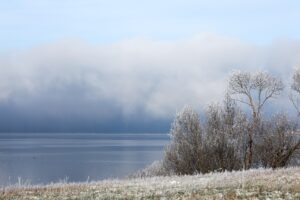
One of the most common questions we are asked here at CanadaDocks is “Can I leave my dock in the water over winter?”.
We ALWAYS recommend removing all type of docks in the winter to prevent any chances of damage occurring. Our 25-year warranty does not cover any damage that may occur with docks left in over winter.
If you have a Standing Dock, it MUST be removed in winter. We will explain why in a moment. The only exception we may make is for a Floating Dock. This is ONLY if your property has the ideal conditions.

Water is nature’s most powerful force! With weather fluctuations, water freezes and melts, causing the ice to expand and contract. This causes enough pressure to damage any material left in its path, like a dock left in the water.
Ice Shove (also known as Ice Surge) or Ice Tsunami, are large surge of ice that gets pushed up onto the shore. This is caused by strong winds or temperature differences sometimes pushing ice at a very rapid rate. They usually on large lakes or oceans that can destroy anything in its path.
In Canada and the northern United States, the cold weather can be very inconsistent. Warmer periods of time in the winter allows ice to melt and shift. The constant freezing and melting, paired with strong winds and snowfalls can be a destructive combination for a dock left in the water.
Videos are from The Weather Network YouTube Channel
Although we do not recommend leaving any dock in the water over winter, there are some shorelines that make it almost impossible to bring a floating dock out of the water. You may be able to keep your floating dock in the water over the winter if the floating dock is located in a protected bay and the fingers are properly disconnected and secured. Keep reading to discover why.
If your docks are in, or can be towed to, a calm protected bay where no ice shove occurs, you may be able to leave it in during the winter. In that case, be sure to disconnect all hinged connections. If your floating dock is a T or L shape layout or has fingers, be sure to disconnect those floating dock connector bracket allowing each straight section to float around separately.
It is best to disconnect your anchor chains from the dock and tie the dock to a tree on shore, which would allow it to move around freely and settle into the ice. If there are no trees on your shoreline you can loosen your anchor chains a few feet to allow the same.

A bay is a recessed body of water connected to a lake or ocean. The land around the recessed section will help protect your shoreline from large waves and high winds making it a safe place to store your dock. Below is a example of a protected bay, notice how the land on the right will protect the dock from any wind or waves coming from that direction.

It is crucial to protect your investment and continue to enjoy your dock for as many years as possible. Follow out easy to follow, step by step guide to removing your dock for the winter. Check out the winter almanac report for the weather trends we are likely to experience this winter.
At CanadaDocks™, we take great pride in designing and constructing top-quality standing docks, floating docks, and dock accessories. All our docks are proudly manufactured at our state-of-the-art facility in Beeton, Ontario, conveniently located just 30 minutes north of the Greater Toronto Area (GTA).
Read our privacy policy